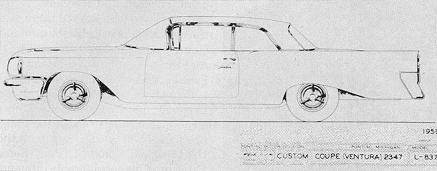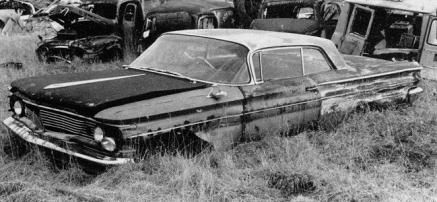

y the time the 1960s rolled around, Pontiac's reputation as a performance marque had been firmly
entrenched on all fronts: stock car racing, drag racing, and most importantly, on the street. Most of the hot Pontiacs sold in those years were carefully optioned Catalinas
and Venturas, and while they were unquestionably high-performance cars, they had the same trim levels as the ubiquitous family transporters of those same model names.
Pontiac wanted to create a car that embodied performance, luxury, and style—one that didn't owe its existence to a couple of option groups on an order sheet. This
was to be the flagship of the fleet, the Grand Prix.
With the four-seat Thunderbird in 1958, Ford had defined a new type of vehicle—the personal luxury car. Product planners
all over Detroit quickly realized that this new market was indeed lucrative. Pontiac wanted to take the concept a step further, though. Whereas the T-Bird was a decent
performer, the new Pontiac would have the potential to be a real mauler, if the customer desired.
|
Department of Archaeology
 If you noticed the similarities
between the 1959 line drawing and the photo of this very rundown 1960, you're not alone. After taking photos of this discovery at a wrecking yard, I
sent them to Pontiac Historian John Sawruk and GM Design Staff's Floyd Joliet. They determined that the car was an early Grand Prix production
proposal. It was painted in what appeared to be Firefrost Blue and sported such features as a fiberglass roof, fiberglass headlight buckets (like the
1960 X-400), metallic blue leather/cloth interior, power everything, and 8-lug wheels. Unfortunately, this car vanished without a trace during the first
week of 1990. Pieces of the car have been found, such as the engine, exterior trim, and interior. It was apparently stripped, but the fate of the rest of
the car is now unknown. We hope to have more on this unfinished story in next issue's Department X. —D.K.
|
|
As far as automotive historians can surmise, the Grand Prix's beginnings came from the desire to design a successor to the
1957-58 Bonnevilles. Remember, in 1959, the Bonneville gained 2 inches in wheelbase and a full 9 inches in length. A car with a leaner look was needed to carry the
upscale performance tradition.
A drawing (right) unearthed a couple of years ago by Pontiac's historian, John Sawruk, is believed to be the first recorded artifact of
the Grand Prix project. In it, we see the driver's-side view of a 1959 Ventura Custom Coupe, with a
nonproduction body style number of 2347. Of particular interest is the roofline, which has a formal profile, unlike the bubbletop that eventually made production.
Sawruk recently conversed with a longtime GM Styling and Design Staff employee who had just retired, and according to him, at
least one 2347 Ventura was actually built in 1959. Its roof was constructed of fiberglass and used specially made rear side windows. The roofline was actually similar to
the Ford retractable hardtop. An interesting side note to the story is that the roof was later removed and grafted onto a 1960 Pontiac experimental car, which the author
discovered in an abandoned upstate New York salvage yard (again, see right).
As time progressed, the formal roofline from 2347 was modified a bit and adopted across the board for the 1962 full-size B-body
coupes. It was from here that the production Grand Prix began to take form. In those days, GM Styling used the name "Ventura" as a generic moniker for most compact
and full-size Pontiac design proposals, even though the same name denoted a Catalina interior trim option (or a separate model, depending on year).
By 1961, the design of the 1962 Grand Prix had been finalized. While sharing the same body as the Catalina/Ventura, many
differences separated the GP from its B-body brethren. For one thing, it would only come as a two-door hardtop. But more important, the Grand Prix broke new ground
for Detroit: It sought elegance in simplicity.
At a time when bigger was better, garish looks were in, and you could calculate the sticker price of a car by measuring the
square footage of its chrome surfaces, the idea of a tastefully restrained exterior was a radical one. The car was nearly devoid of bright side trim, save for a lower rocker
molding. Up front, the grille was a fine-mesh design, accented by a racing-inspired "chequered flag" badge. The rear-panel treatment was also unique to the GP, with a
full-width molding that mimicked the grille design, right down to the badge.
NEXT >
|
|